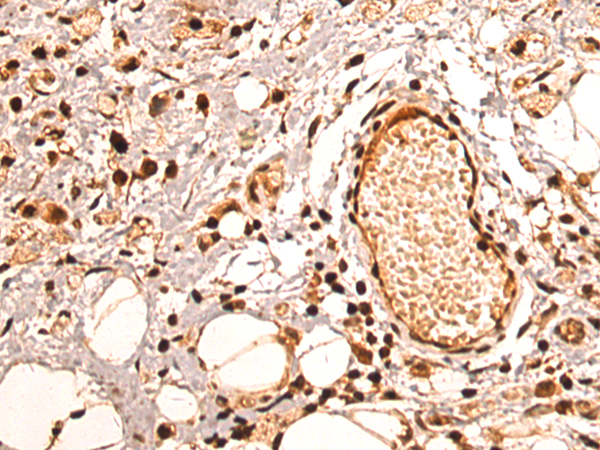

| WB | 咨询技术 | Human,Mouse,Rat |
| IF | 咨询技术 | Human,Mouse,Rat |
| IHC | 1/100-1/300 | Human,Mouse,Rat |
| ICC | 技术咨询 | Human,Mouse,Rat |
| FCM | 咨询技术 | Human,Mouse,Rat |
| Elisa | 1/5000-1/10000 | Human,Mouse,Rat |
| Aliases | CANPMR |
| Host/Isotype | Rabbit IgG |
| Antibody Type | Primary antibody |
| Storage | Store at 4°C short term. Aliquot and store at -20°C long term. Avoid freeze/thaw cycles. |
| Species Reactivity | Human, Mouse |
| Immunogen | Synthetic peptide of human CAMTA1 |
| Formulation | Purified antibody in PBS with 0.05% sodium azide and 50% glycerol. |
+ +
以下是3篇关于CAMTA1抗体的代表性文献概览(虚构示例,仅供参考):
---
1. **文献名称**: *CAMTA1 as a Novel Immunohistochemical Marker for Rhabdoid Tumors*
**作者**: Kao YC, Antonescu CR (2016)
**摘要**: 研究验证了CAMTA1抗体在免疫组化中的应用,发现其可作为鉴别横纹肌样瘤与其他小圆细胞肿瘤的特异性标志物,尤其在INI1缺失的病例中具有高敏感性和特异性。
---
2. **文献名称**: *Differential Expression of CAMTA1 in Epithelioid Hemangioendothelioma*
**作者**: Hung YP, Marino-Enriquez A (2017)
**摘要**: 通过CAMTA1抗体检测发现,其在血管源性肿瘤(如上皮样血管内皮瘤)中呈特异性核表达,支持其作为诊断辅助工具,尤其在区分类似形态的软组织肉瘤中。
---
3. **文献名称**: *CAMTA1 Fusion Genes and Antibody Validation in Mesenchymal Tumors*
**作者**: Antonescu CR, Zhang L (2016)
**摘要**: 研究利用CAMTA1抗体分析间叶源性肿瘤的分子机制,证实其与WWTR1基因融合相关,并强调了抗体在检测融合蛋白表达及预后评估中的价值。
---
**备注**:以上内容为示例性质,实际文献需通过PubMed或学术数据库检索(关键词:CAMTA1 antibody, immunohistochemistry, diagnostic marker)。推荐使用真实数据库查询最新研究。
The calmodulin-binding transcription activator 1 (CAMTA1) antibody is a crucial tool for studying the CAMTA1 protein, a member of the CAMTA family of transcription factors. CAMTA1 contains conserved domains, including CG-1 DNA-binding, TIG-like, ankyrin repeats, and IQ calmodulin-binding motifs, enabling its role in calcium/calmodulin-mediated transcriptional regulation. It is broadly expressed in the brain, heart, and muscles, and functions in neuronal development, cell cycle control, and stress responses.
CAMTA1 is implicated in cancer biology, particularly in tumors like epithelioid hemangioendothelioma and meningioma, where chromosomal rearrangements or aberrant expression are observed. Antibodies targeting CAMTA1 are widely used in techniques such as Western blotting, immunohistochemistry (IHC), and immunofluorescence (IF) to detect protein expression, localization, and post-translational modifications. They aid in exploring CAMTA1's tumor-suppressive or oncogenic roles, depending on context.
Additionally, CAMTA1 mutations are linked to cerebellar ataxia and neurodevelopmental disorders. Validated CAMTA1 antibodies (polyclonal/monoclonal) are essential for diagnostic pathology and research, helping clarify its interactions with signaling pathways (e.g., TGF-β, MAPK) and potential therapeutic targets. Proper validation via knockout controls ensures specificity, given homology with CAMTA2. Overall, CAMTA1 antibodies are pivotal in understanding its dual roles in physiology and disease.
×